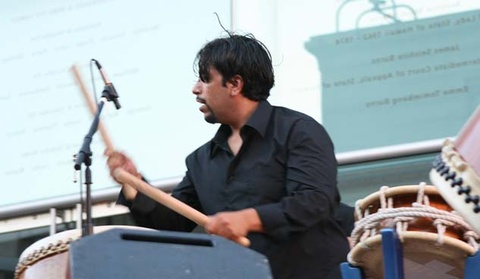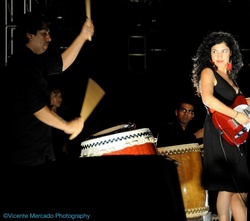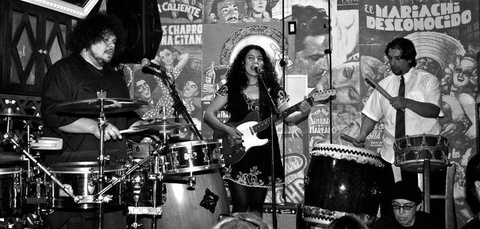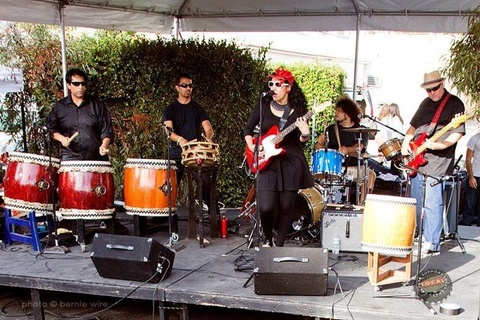Maceo Hernandez is aptly nicknamed, “The Demon Drummer of East LA.” His story is one of identity, perseverance, and the blending of two cultures, while the heart-pounding beats of the taiko drum take center stage.
Born in East LA to an activist mother, Barbara Hernandez, Maceo had a chance encounter with taiko drums at a wedding reception. Barbara, an activist during the Chicano Civil Rights Movement, was a friend of Japanese American activist, Yuri Mary Kochiyama. It was at Yuri’s son’s wedding that Maceo first observed a taiko performance. He felt the energy and power of each beat; a profound combination that left a lasting impression on the 12 year old.

Maceo Hernandez at the 1st and Central Summer Concerts 2007 event outside of the Japanese American National Museum. Photo by Richard Murakami.
Soon afterwards, Maceo started taking taiko lessons at Sozenji Buddhist Temple in Montebello. He first started playing background, the bass and some percussion instruments and eventually graduated to solos. About three years later, he had another chance encounter—this time it was with Den Tagayasu, founder of Japan’s premier taiko group, Ondekoza. Ondekoza came to town and Mr. Tagayasu was taken by Maceo’s talent. Impressed with his youthfulness and enthusiasm for taiko, Mr. Tagayasu recruited Maceo to join Ondekoza’s tour in Europe and Japan.
This next chapter in Maceo’s life saw triumphs, albeit not without challenges. Good family friend and producer/director John Esaki chronicled Maceo’s journey to becoming a professional taiko drummer in Maceo: Demon Drummer of East L.A. As Maceo’s journey took off, both physically, from East LA to Japan, and artistically, from novice to professional, his identity as a Chicano cannot go understated or dismissed. Maceo proudly states, “When I play, I try to bring the Mexican in me, the Chicano in me.”

Maceo and Lysa Flores at Grand Performances in Downtown Los Angeles. Photo courtesy of Vicente Mercado Photography.
As mentioned in Esaki’s documentary, Mr. Tagayasu was aware of racist views among older Japanese. He sought to use Maceo and his talents to break those barriers. Maceo wonderfully illustrates this notion when he says in his own words in Japanese, “East Los Angeles wa boku no “la raza.” East Los Angeles wa boku no family.” In translation: “East Los Angeles is my “la raza (the race).” East Los Angeles is my family.”
Once in Japan, the Ondekoza team members had to adhere to a very rigorous training schedule: wake up at 5:30am, run, cook, practice taiko, and run again. Although difficult, the strict schedule helped the team improve stamina and develop discipline. The long-distance running was also part training for the New York Marathon that Ondekoza planned to run as a team. A performance at Carnegie Hall the day after the race was also scheduled.
One day, as Maceo was on a 30-mile run, his leg was injured from a metal pipe that had fallen from a truck. His left leg was eventually amputated. Dark days followed but those dark days were followed with gumption and the desire to play taiko again. Esaki’s documentary reveals that Maceo was drawn to the taiko drums even from his wheelchair. He pushed for a quick recovery because he wanted to run the marathon and perform at Carnegie Hall as planned. A short seven months later, and with a lot of perseverance, Maceo completed the New York Marathon and performed a solo, on the Odaiko or “big drums” at the finish line.
The accident was not a setback and it certainly does not define him. Clearly, Maceo has beautifully and masterfully integrated his Chicano self, his perseverance through the ups and downs, and his beloved taiko into one identity—an identity that the people of East LA and JA communities consider as their own.

East LA Taiko members Fredo, Maceo, and Lysa performing at East Side Luv. Photo courtesy of Maceo Hernandez.
Below is an exchange of Q&As with Maceo that yielded an insightful look into his early days with Ondekoza and his current endeavors.
Q: How did you get the nickname, “Demon Drummer of East LA”?
A: That’s my nickname because the group I was with in Japan, “Ondekoza,” is known as the “Demon Drummers of Japan.” And I’m from East LA. “Ondekoza” translates to “Demon Drum Group.”
Q: You saw a taiko performance for the first time at a friend’s wedding. Can you describe the thoughts and emotions you felt upon hearing taiko drums that first time? What impressions did it leave?
A: I remember feeling the power and energy coming from taiko at the wedding. It hit my soul so hard that I knew I had to play that drum.
Q: Looking back, how would you describe your time touring Europe and Japan with Ondekoza?
A: Traveling to Japan and Europe at such a young age was eye opening. It helped me appreciate what a big, wonderful world we live in. I was thrilled to be a Chicano sharing Japanese culture with Europeans.
Q: How long did you live in Japan? Also, how was your experience adjusting to life in Japan?
A: I was a performing member with Ondekoza for 4 years. Lots of traveling back and forth from Japan to Los Angeles. The longest time without traveling outside Japan was 2 years straight. I was able to adjust pretty easily. As an artist, I was thrilled to learn different types of art that Japan had.
Q: Can you describe your experience performing at Carnegie Hall?
A: Carnegie Hall was amazing. The history, stage, and sound blew me away. Our leader had us sit in every level to experience the beauty of the stage we were about to play.
Q: Completing the New York Marathon is a huge accomplishment and you’ve done it twice. What was the driving force that helped you cross the finish line each time?
A: Both marathons were tough but I had trained years for those two moments. The stamina and training I endured with Ondekoza helped me accomplish those goals of crossing the finish line. Finishing the first marathon was a way for me to thank all the people that encouraged me to fight on after my accident. The second was more for me.
Q: How often do you play taiko now?
A: I currently teach a class in Rowland Heights once a week and I give private lessons. I’m hoping to start a taiko training class in Los Angeles soon.
Q: Can you describe the connection you feel with the Japanese American community?
A: Just like living in the Eastside, Little Tokyo and the Japanese American communities have always been home. From performing taiko on floats during Nisei Week multiple times, volunteering at Sozenji Obon, to performing/teaching taiko at JANM and hanging out with my family at Visual Communications, I’ve loved my time within the Japanese American community. I really did grow up in Little Tokyo. Reading books at Amerasia Bookstore, getting my California rolls when Mitsuru Grill was still a drug store, to my trips to Manzanar with Mike Murase. The community has always been wonderful to me. Having my birthday parties at Far East to late night eating at Atomic Cafe…I really can go on and on.
Q: Many see you as a “bridge” for the Japanese American community and East Los Angeles. How do you view taiko or music in general as a medium to bring communities together?
A: I think the art of music is still the best thing that can bring people together. I’ve been able to combine what I learned in taiko to my Latin roots. That’s given me the opportunity to perform in the Eastside and bring them something different to experience. Performing at my junior high school (Robert Louis Stevenson Middle School) in East LA was just as amazing as performing at Carnegie Hall. To see the looks on those kids’ faces…it was the same look I had watching taiko for the first time.
Q: Do you have any new projects you are working on?
A: At the moment I’m working with Lysa Flores on some of our new East LA Taiko (ELAT) songs. She has an amazing voice with the same power the taiko gives. I’m also doing music for a dramatic play that involves boxing. Also, I will be starting a new project with shakuhachi (a Japanese end-blown flute) master Marco Lienhard, leader of New York’s Taikoza.
Q: Do you have any advice for people who would like to learn to play taiko?
A: I encourage everyone to try taiko. When I first started playing taiko, there were only a handful of groups in America. But now it’s in every major city and in so many colleges. It’s easier to find a group to learn taiko. JANM offers workshops all the time.
Q: What is your favorite Japanese food?
A: Ramen and takoyaki. It’s actually a dream of mine to open a ramen/takoyaki shop in Boyle Heights when I’m older.
The Demon Drummer featuring ramen and takoyaki. Now, that’s a performance we should keep our fingers crossed for!
* * *
Performance by East LA Taiko with Lysa Flores
at 2014 NATSUMATSURI FAMILIY FESTIVAL
Japanese American National Museum
August 9 at 4 p.m.
FREE!
Enjoy a unique blend of Latin rhythms and taiko drumming with an energetic performance by East LA Taiko with Lysa Flores. Before the performance, JANM will screen an excerpt from Maceo: Demon Drummer of East LA, the award-winning film about East LA Taiko’s leader Maceo Hernandez. The film was produced and directed by John Esaki, Director of JANM’s Frank H. Watase Media Arts Center.
For more information about Natsumatsuri Family Festival >>
© 2014 Japanese American National Museum






